Pecharsky V.K., Zavalij P.Y. Fundamentals of Powder Diffraction and Structural Characterization of Materials
Подождите немного. Документ загружается.

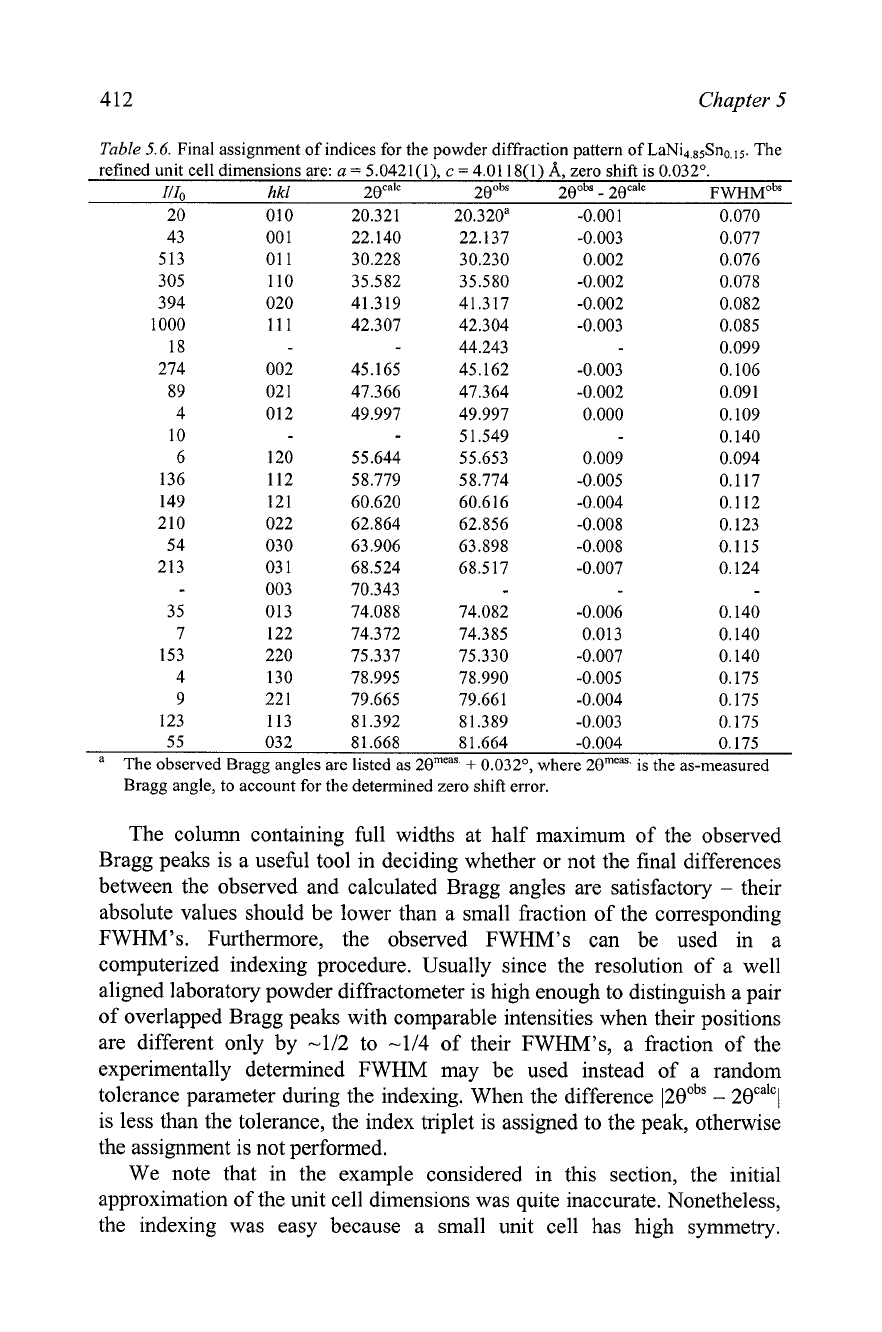
412
Chapter
5
Table 5.6.
Final assignment of indices for the powder diffraction pattern of LaNi4.ssSno.lS. The
refined unit cell dimensions are:
a
=
5.0421(1),
c
=
4.01 18(1)
A,
zero shift is
0.032O.
Ill, hkl
2e~a~~
2o0b" 200bs-2eca'~
FWHMO~~
20 010
20.321 20.320"
-0.00 1 0.070
43 00
1
22.140 22.137
-0.003 0.077
513 01 1
30.228 30.230
0.002 0.076
305 110 35.582
35.580
-0.002 0.078
394 020 41.319
41.317
-0.002 0.082
1000 111 42.307 42.304
-0.003 0.085
18 44.243 0.099
274 002 45.165 45.162 -0.003 0.106
89 02 1
47.366 47.364
-0.002 0.091
4 012 49.997 49.997 0.000 0.109
10 5 1.549 0.140
6 120 55.644 55.653 0.009 0.094
136 112 58.779 58.774 -0.005 0.117
149 121 60.620 60.616 -0.004 0.112
210 022 62.864 62.856 -0.008 0.123
54 030
63.906 63.898
-0.008 0.1 15
213 03
1
68.524 68.517
-0.007 0.124
003 70.343
3 5 013 74.088 74.082 -0.006 0.140
7 122 74.372 74.385 0.013 0.140
153 220 75.337 75.330
-0.007 0.140
4 130
78.995 78.990
-0.005 0.175
9 22
1
79.665 79.661
-0.004 0.175
123 113
8 1.392 81.389 -0.003 0.175
55 032 8 1.668 8 1.664 -0.004 0.175
a
The observed Bragg angles are listed as
2emeas
+
0.032',
where
2eme".
is the as-measured
Bragg angle, to account for the determined zero shift error.
The column containing full widths at half maximum of the observed
Bragg peaks is a useful tool in deciding whether or not the final differences
between the observed and calculated Bragg angles are satisfactory
-
their
absolute values should be lower than a small fraction of the corresponding
FWHM's. Furthermore, the observed FWHM's can be used in a
computerized indexing procedure. Usually since the resolution of a well
aligned laboratory powder diffractometer is high enough to distinguish a pair
of overlapped Bragg peaks with comparable intensities when their positions
are different only by -112 to -114 of their FWHM's, a fraction of the
experimentally determined FWHM may be used instead of a random
tolerance parameter during the indexing. When the difference
1290bS
-
29ca1C~
is less than the tolerance, the index triplet is assigned to the peak, otherwise
the assignment is not performed.
We note that in the example considered in this section, the initial
approximation of the unit cell dimensions was quite inaccurate. Nonetheless,
the indexing was easy because a small unit cell has high symmetry.
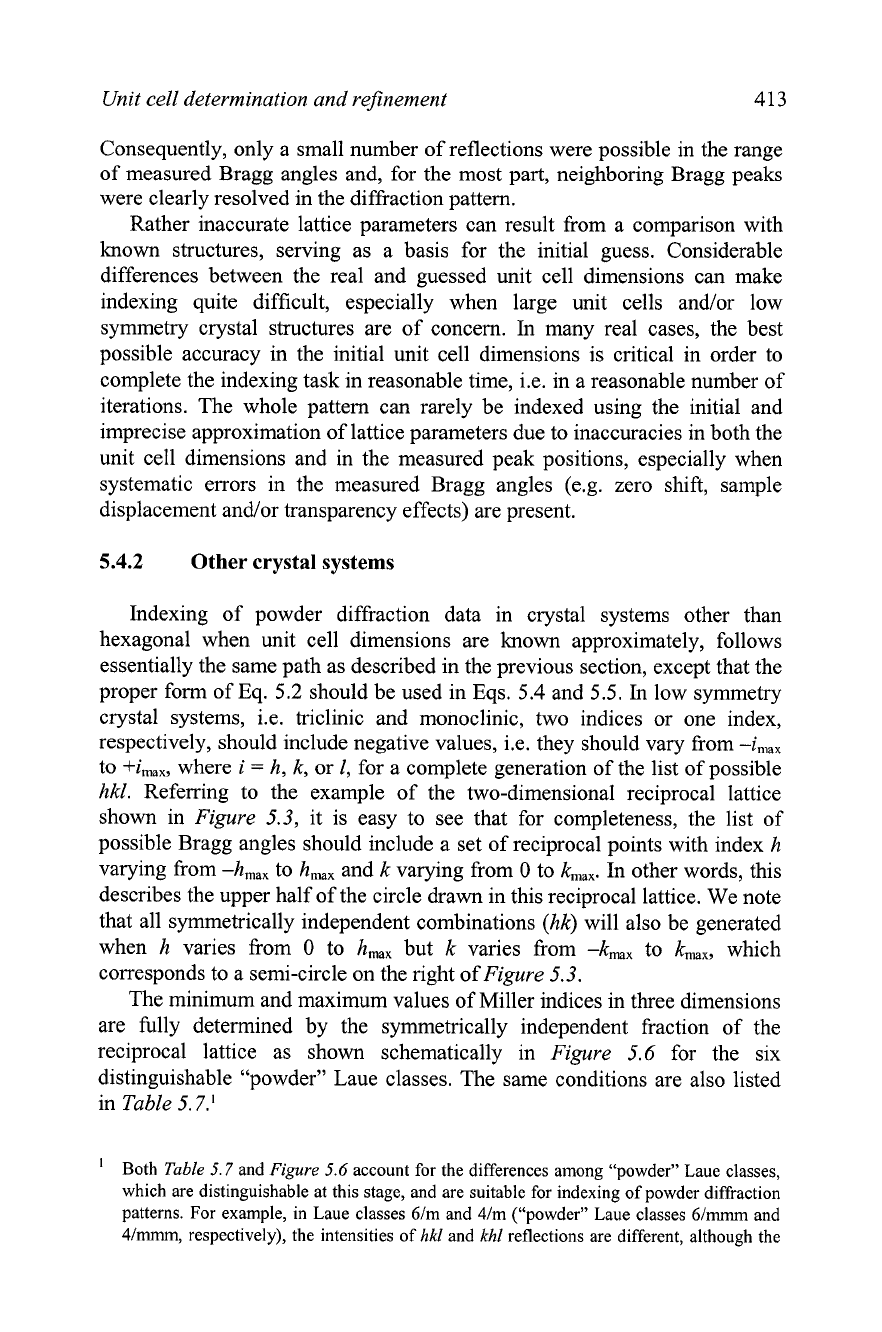
Unit cell determination and refinement
413
Consequently, only a small number of reflections were possible in the range
of measured Bragg angles and, for the most part, neighboring Bragg peaks
were clearly resolved in the diffraction pattern.
Rather inaccurate lattice parameters can result from a comparison with
known structures, serving as a basis for the initial guess. Considerable
differences between the real and guessed unit cell dimensions can make
indexing quite difficult, especially when large unit cells
and/or low
symmetry crystal structures are of concern. In many real cases, the best
possible accuracy in the initial unit cell dimensions is critical in order to
complete the indexing task in reasonable time, i.e. in a reasonable number of
iterations. The whole pattern can rarely be indexed using the initial and
imprecise approximation of lattice parameters due to inaccuracies in both the
unit cell dimensions and in the measured peak positions, especially when
systematic errors in the measured Bragg angles
(e.g. zero shift, sample
displacement
andlor transparency effects) are present.
5.4.2
Other crystal systems
Indexing of powder diffraction data in crystal systems other than
hexagonal when unit cell dimensions are known approximately, follows
essentially the same path as described in the previous section, except that the
proper form of Eq.
5.2
should be used in Eqs.
5.4
and
5.5.
In low symmetry
crystal systems, i.e. triclinic and monoclinic, two indices or one index,
respectively, should include negative values, i.e. they should vary from
-in,,,
to +i,,,, where i
=
h,
k,
or
I,
for a complete generation of the list of possible
hkl.
Referring to the example of the two-dimensional reciprocal lattice
shown in
Figure
5.3, it is easy to see that for completeness, the list of
possible Bragg angles should include a set of reciprocal points with index h
varying from -h,,, to h,, and k varying from
0
to k,,,. In other words, this
describes the upper half of the circle drawn in this reciprocal lattice. We note
that all symmetrically independent combinations (hk) will also be generated
when h varies from
0
to h,,, but
k
varies from -kmx to k,,,, which
corresponds to a semi-circle on the right of
Figure
5.3.
The minimum and maximum values of Miller indices in three dimensions
are fully determined by the symmetrically independent fraction of the
reciprocal lattice as shown schematically in
Figure
5.6 for the six
distinguishable "powder" Laue classes. The same conditions are also listed
in
Table
5.7.'
Both
Table
5.7
and
Figure
5.6
account for the differences among "powder" Laue classes,
which are distinguishable at this stage, and are suitable for indexing of powder diffraction
patterns. For example, in Laue classes 6/m and 4/m ("powder" Laue classes 6/mmm and
4/mmm, respectively), the intensities of
hkl
and
khl
reflections are different, although the
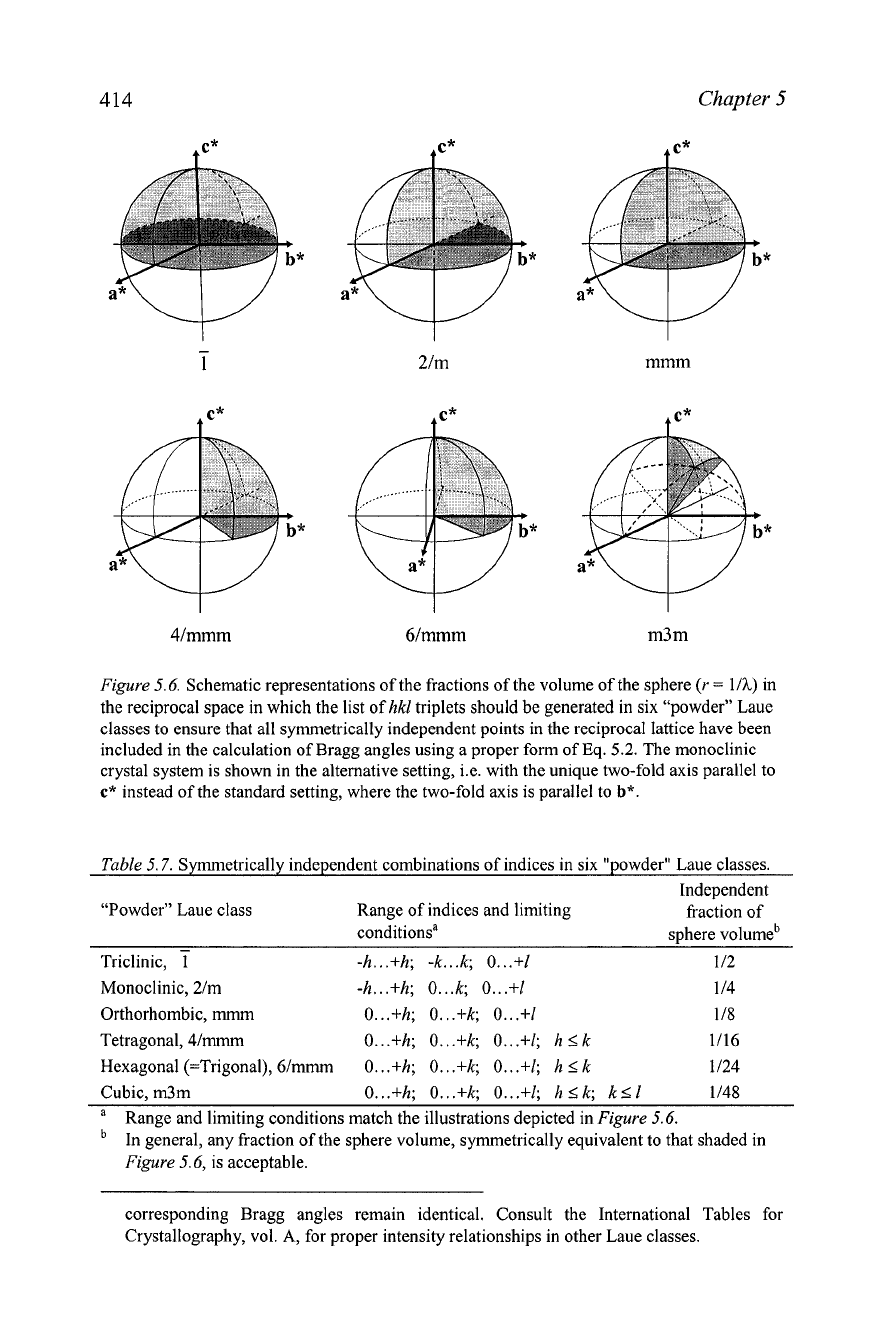
Chapter
5
mmm
Figure
5.6.
Schematic representations of the fractions of the volume of the sphere
(r
=
l/h) in
the reciprocal space in which the list of
hkl
triplets should be generated in six "powder" Laue
classes to ensure that all symmetrically independent points in the reciprocal lattice have been
included in the calculation of Bragg angles using a proper form of Eq. 5.2. The monoclinic
crystal system is shown in the alternative setting, i.e. with the unique two-fold axis parallel to
c*
instead of the standard setting, where the two-fold axis is parallel to
b*.
Table
5.7.
Symmetrically independent combinations of indices in six "powder" Laue classes.
Independent
"Powder" Laue class Range of indices and limiting fraction of
conditionsa sphere volumeb
-
Triclinic, 1
-h.. .+h; -k.
..k;
0. ..+1
112
Monoclinic, 2/m
-h.. .+h; 0.
..k;
0..
.+1
1 14
Orthorhombic,
mmm
O...+h;
O...+k;
O...+l
118
Tetragonal, 4/mmm
O...+h; O...+k; O...+l; hlk
1/16
Hexagonal (=Trigonal), 6/mmrn
0.. .+h; 0..
.+k;
0..
.+1;
h
l
k
1/24
Cubic, m3m
O...+h; O...+k; O...+1; hsk; kll
1/48
a
Range and limiting conditions match the illustrations depicted in
Figure
5.6.
In general, any fraction of the sphere volume, symmetrically equivalent to that shaded in
Figure
5.6,
is acceptable.
corresponding Bragg angles remain identical. Consult the International Tables for
Crystallography, vol.
A,
for proper intensity relationships in other Laue classes.
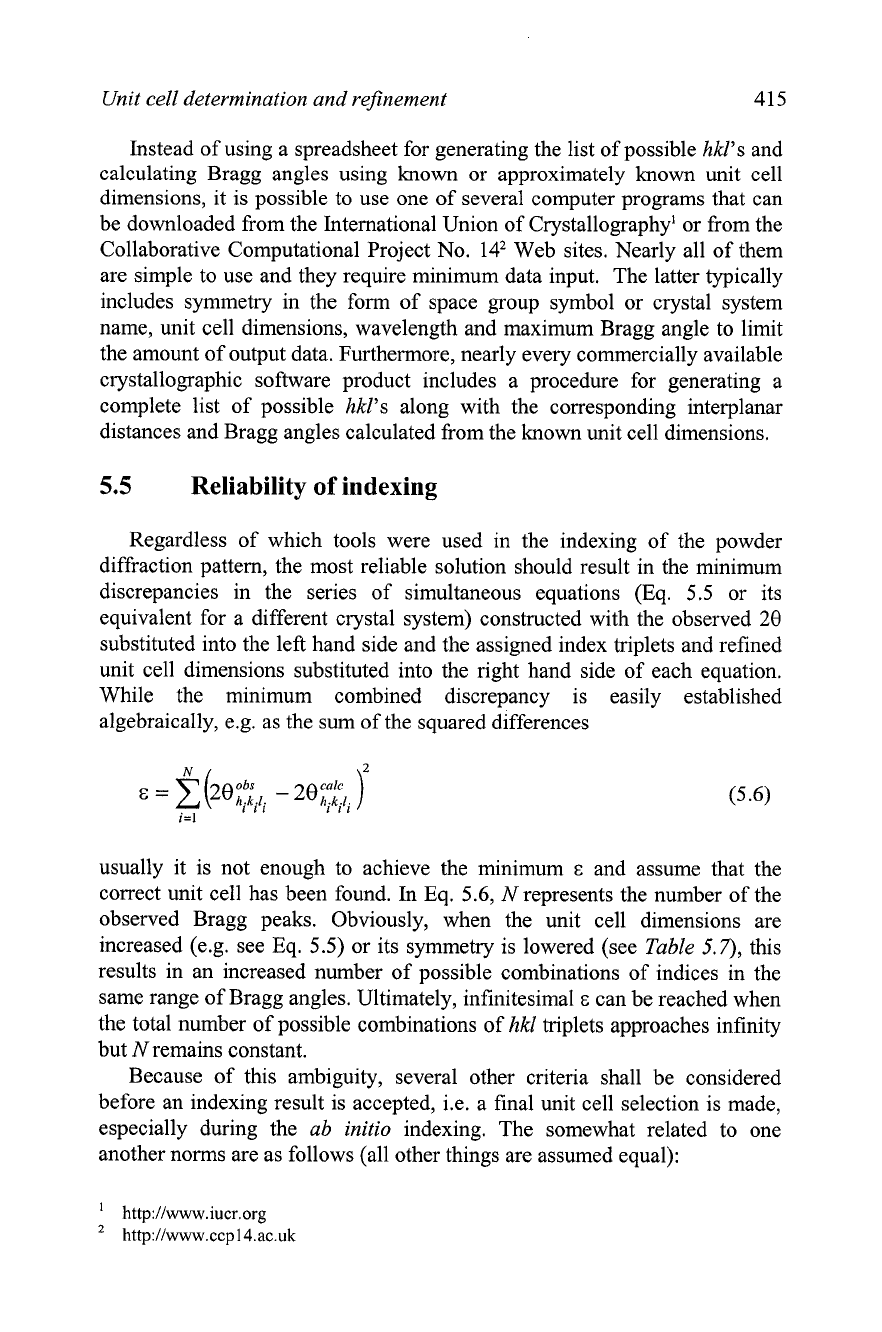
Unit cell determination and refinement
415
Instead of using a spreadsheet for generating the list of possible
hkl's and
calculating Bragg angles using known or approximately known unit cell
dimensions, it is possible to use one of several computer programs that can
be downloaded from the International Union of Crystallography' or from the
Collaborative Computational Project No.
142 Web sites. Nearly all of them
are simple to use and they require minimum data input. The latter typically
includes symmetry in the form of space group symbol or crystal system
name, unit cell dimensions, wavelength and maximum Bragg angle to limit
the amount of output data. Furthermore, nearly every commercially available
crystallographic software product includes a procedure for generating a
complete list of possible hkl's along with the corresponding interplanar
distances and Bragg angles calculated from the known unit cell dimensions.
5.5
Reliability
of
indexing
Regardless of which tools were used in the indexing of the powder
diffraction pattern, the most reliable solution should result in the minimum
discrepancies in the series of simultaneous equations (Eq. 5.5 or its
equivalent for a different crystal system) constructed with the observed
28
substituted into the left hand side and the assigned index triplets and refined
unit cell dimensions substituted into the right hand side of each equation.
While the minimum combined discrepancy is easily established
algebraically,
e.g. as the sum of the squared differences
usually it is not enough to achieve the minimum
E
and assume that the
correct unit cell has been found. In Eq.
5.6,
N
represents the number of the
observed Bragg peaks. Obviously,
when the unit cell dimensions are
increased (e.g. see Eq. 5.5) or its symmetry is lowered (see Table
5.7),
this
results in an increased number of possible combinations of indices in the
same range of Bragg angles. Ultimately, infinitesimal
E
can be reached when
the total number of possible combinations of hkl triplets approaches infinity
but
N
remains constant.
Because of this ambiguity, several other criteria shall be considered
before an indexing result is accepted, i.e. a final unit cell selection is made,
especially during the ab initio indexing. The somewhat related to one
another norms are as follows (all other things are assumed equal):
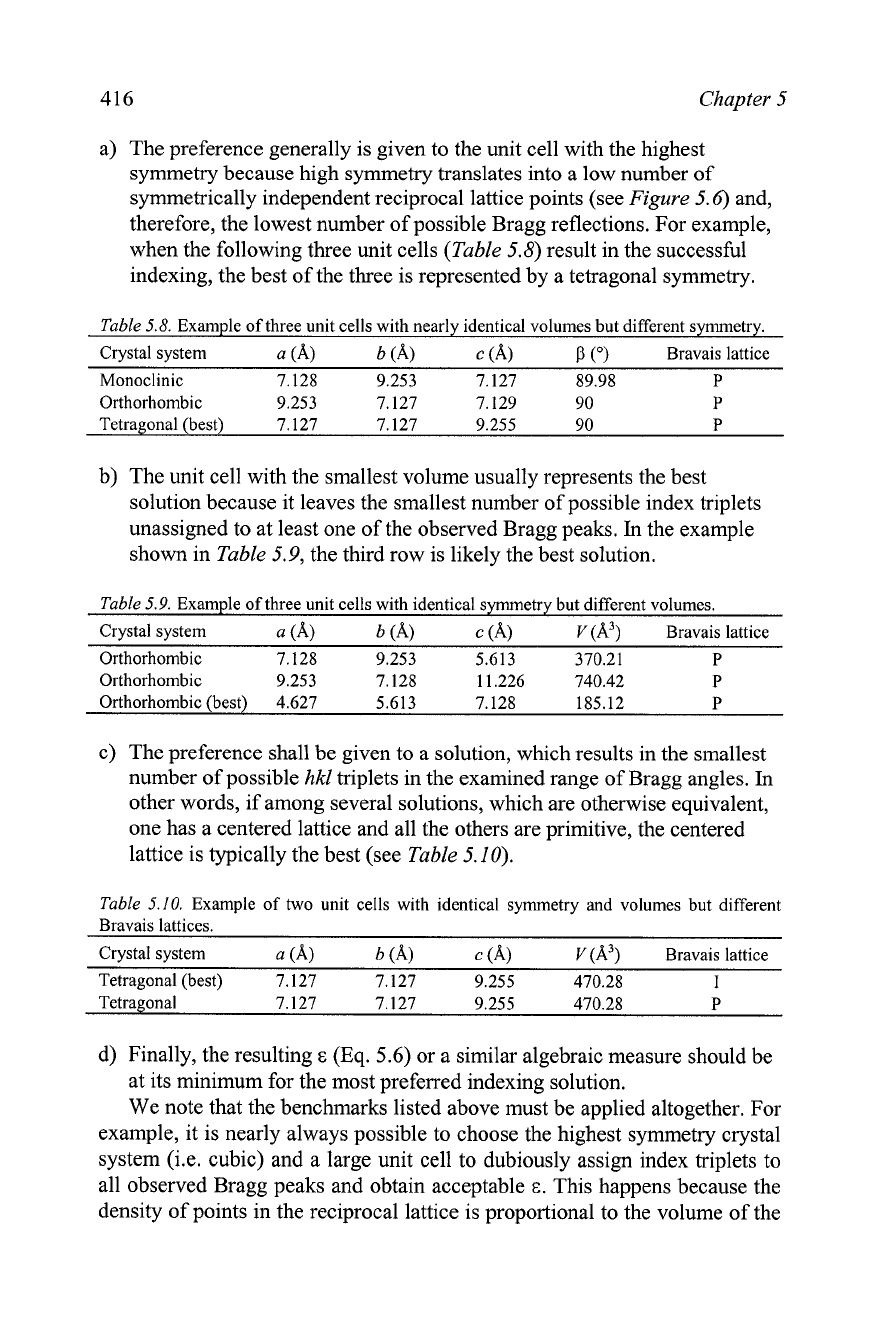
416 Chapter
5
a) The preference generally is given to the unit cell with the highest
symmetry because high symmetry translates into a low number of
symmetrically independent reciprocal lattice points (see Figure
5.6)
and,
therefore, the lowest number of possible Bragg reflections. For example,
when the following three unit cells (Table 5.8) result in the successful
indexing, the best of the three is represented by a tetragonal symmetry.
Table
5.8.
Example of three unit cells with nearly identical volumes but different symmetry.
Crystal system
a
(A)
b
(A)
c
(A)
P
("1
Bravais lattice
Monoclinic
7.128 9.253 7.127 89.98
P
Orthorhombic
9.253 7.127 7.129 90
P
Tetragonal (best)
7.127 7.127 9.255 90
P
b)
The unit cell with the smallest volume usually represents the best
solution because it leaves the smallest number of possible index triplets
unassigned to at least one of the observed Bragg peaks.
In
the example
shown in Table 5.9, the third row is likely the best solution.
Table
5.9.
Example of three unit cells with identical symmetry but different volumes.
Crystal system
a
(4
b
(A)
C
(A)
v
(A3) Bravais lattice
Orthorhombic
7.128 9.253 5.613 370.21
P
Orthorhombic
9.253
7.128
1 1.226 740.42
P
Orthorhombic (best)
4.627
5.613
7.128 185.12
P
c) The preference shall be given to a solution, which results in the smallest
number of possible hkl triplets in the examined range of Bragg angles.
In
other words, if among several solutions, which are otherwise equivalent,
one has a centered lattice and all the others are primitive, the centered
lattice is typically the best (see Table 5.10).
Table
5.10.
Example of two unit cells with identical symmetry and volumes but different
Bravais lattices.
Crystal system
a
(A)
b
(A)
c
(A)
v
(A3) Bravais lattice
Tetragonal (best)
7.127
7.127 9.255
470.28
I
Tetragonal
7.127
7.127 9.255
470.28
P
d) Finally, the resulting
E
(Eq.
5.6)
or a similar algebraic measure should be
at its minimum for the most preferred indexing solution.
We note that the benchmarks listed above must be applied altogether. For
example, it is nearly always possible to choose the highest symmetry crystal
system
(i.e, cubic) and a large unit cell to dubiously assign index triplets to
all observed Bragg peaks and obtain acceptable
E.
This happens because the
density of points in the reciprocal lattice is proportional to the volume of the
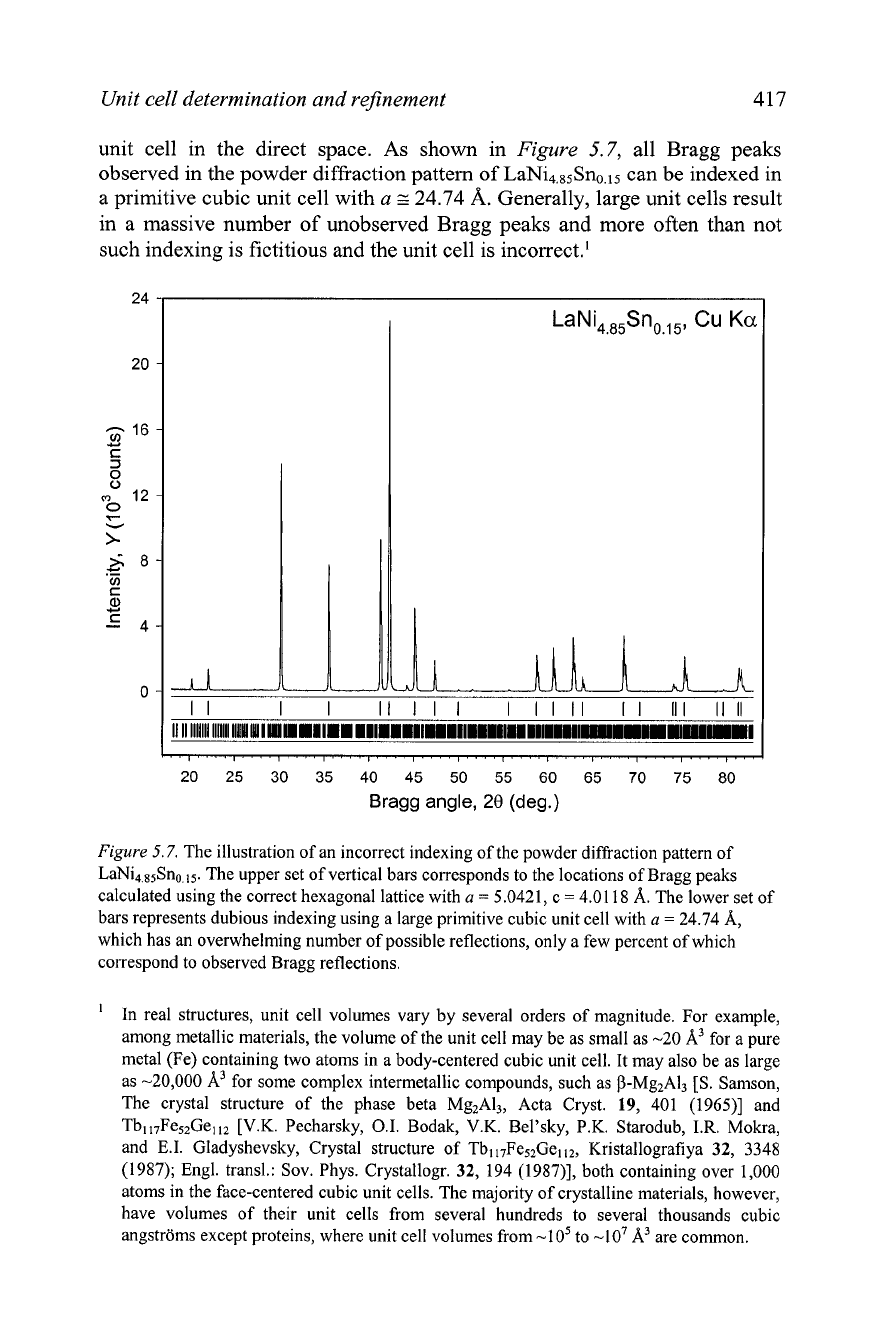
Unit cell determination and refinement
417
unit cell in the direct space. As shown in
Figure
5.7, all Bragg peaks
observed in the powder diffraction pattern of LaNi4.85Sn0.15 can be indexed in
a primitive cubic unit cell with
a
z
24.74
A.
Generally, large unit cells result
in a massive number of unobserved Bragg peaks and more often than not
such indexing is fictitious and the unit cell is incorrect.'
20 25 30 35
40
45 50 55 60 65 70 75 80
Bragg angle,
28
(deg.)
Figure
5.7.
The illustration of an incorrect indexing of the powder diffraction pattern of
LaNi4,85Sno.,5. The upper set of vertical bars corresponds to the locations of Bragg peaks
calculated using the correct hexagonal lattice with
a
=
5.0421, c
=
4.01 18 A. The lower set of
bars represents dubious indexing using a large primitive cubic unit cell with
a
=
24.74 A,
which has an overwhelming number of possible reflections, only a few percent of which
correspond to observed Bragg reflections.
'
In real structures, unit cell volumes vary by several orders of magnitude. For example,
among metallic materials, the volume of the unit cell may be as small as -20 A3 for a pure
metal (Fe) containing two atoms in a body-centered cubic unit cell. It may also be as large
as -20,000
A3
for some complex intermetallic compounds, such as P-Mg2AI3 [S. Samson,
The crystal structure of the phase beta Mg2AI3, Acta Cryst.
19,
401 (1965)l and
Tbl17Fe52Gell,
[V.K.
Pecharsky, 0.1. Bodak, V.K. Bel'sky, P.K. Starodub,
I.R.
Mokra,
and E.I. Gladyshevsky, Crystal structure of Tbl17Fe52Gel12, Kristallografiya
32,
3348
(1987); Engl. transl.: Sov. Phys. Crystallogr.
32,
194
(1987)], both containing over 1,000
atoms in the face-centered cubic unit cells. The majority of crystalline materials, however,
have volumes of their unit cells from several hundreds to several thousands cubic
angstroms except proteins, where unit cell volumes from
-lo5 to -lo7 A3 are common.
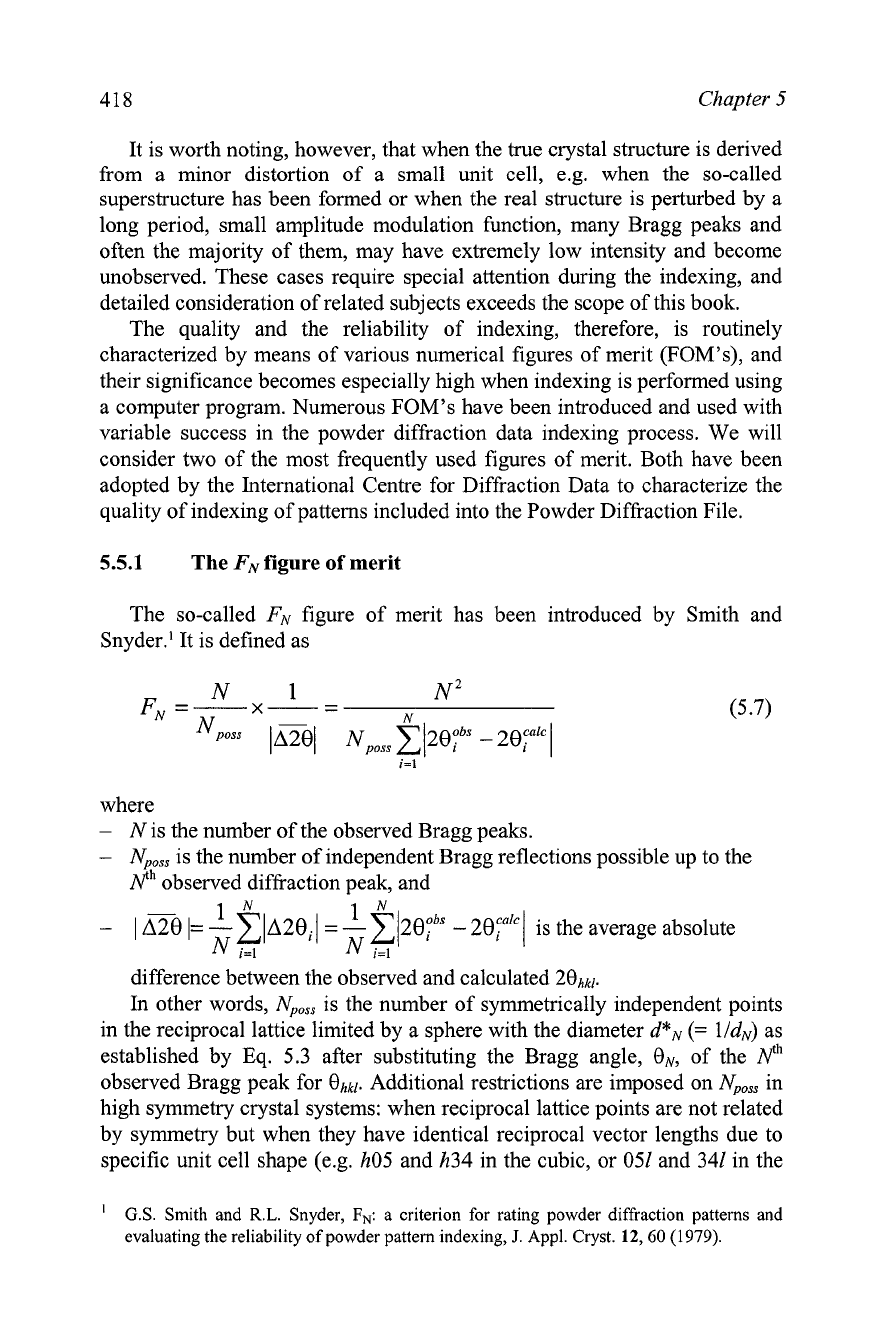
418 Chapter
5
It is worth noting, however, that when the true crystal structure is derived
from
a
minor distortion of a small unit cell,
e.g. when the so-called
superstructure has been formed or when the real structure is perturbed by a
long period, small amplitude modulation function, many Bragg peaks and
often the majority of them, may have extremely low intensity and become
unobserved. These cases require special attention during the indexing, and
detailed consideration of related subjects exceeds the scope of this book.
The quality and the reliability of indexing, therefore, is routinely
characterized by means of various numerical figures of merit
(FOM's), and
their significance becomes especially high when indexing is performed using
a computer program. Numerous FOM's have been introduced and used with
variable success in the powder diffraction data indexing process. We will
consider two of the most frequently used figures of merit. Both have been
adopted by the International Centre for Diffraction Data to characterize the
quality of indexing of patterns included into the Powder Diffraction File.
5.5.1
The
FN
figure of merit
The so-called
FN
figure of merit has been introduced by Smith and
Snyder.' It is defined as
where
N
is the number of the observed Bragg peaks.
NpoSs
is the number of independent Bragg reflections possible up to the
Mh
observed diffraction peak, and
IN
lN
1
AT0
I=
-
z1~20~
/
=
-
z120;bs
-
20~''
I
is the average absolute
N
i=1
N
i=1
difference between the observed and calculated 2ehk[.
In other words,
N,,,,,
is the number of symmetrically independent points
in the reciprocal lattice limited by a sphere with the diameter d*N
(=
lldN) as
established by Eq. 5.3 after substituting the Bragg angle, ON, of the
Nth
observed Bragg peak for €Ihkl. Additional restrictions are imposed on
N,,,
in
high symmetry crystal systems: when reciprocal lattice points are not related
by symmetry but when they have identical reciprocal vector lengths due to
specific unit cell shape
(e.g. h05 and h34 in the cubic, or 051 and 341 in the
'
G.S. Smith and
R.L.
Snyder,
FN:
a criterion for rating powder diffraction patterns and
evaluating the reliability of powder pattern indexing,
J.
Appl. Cryst.
12,60
(1979).
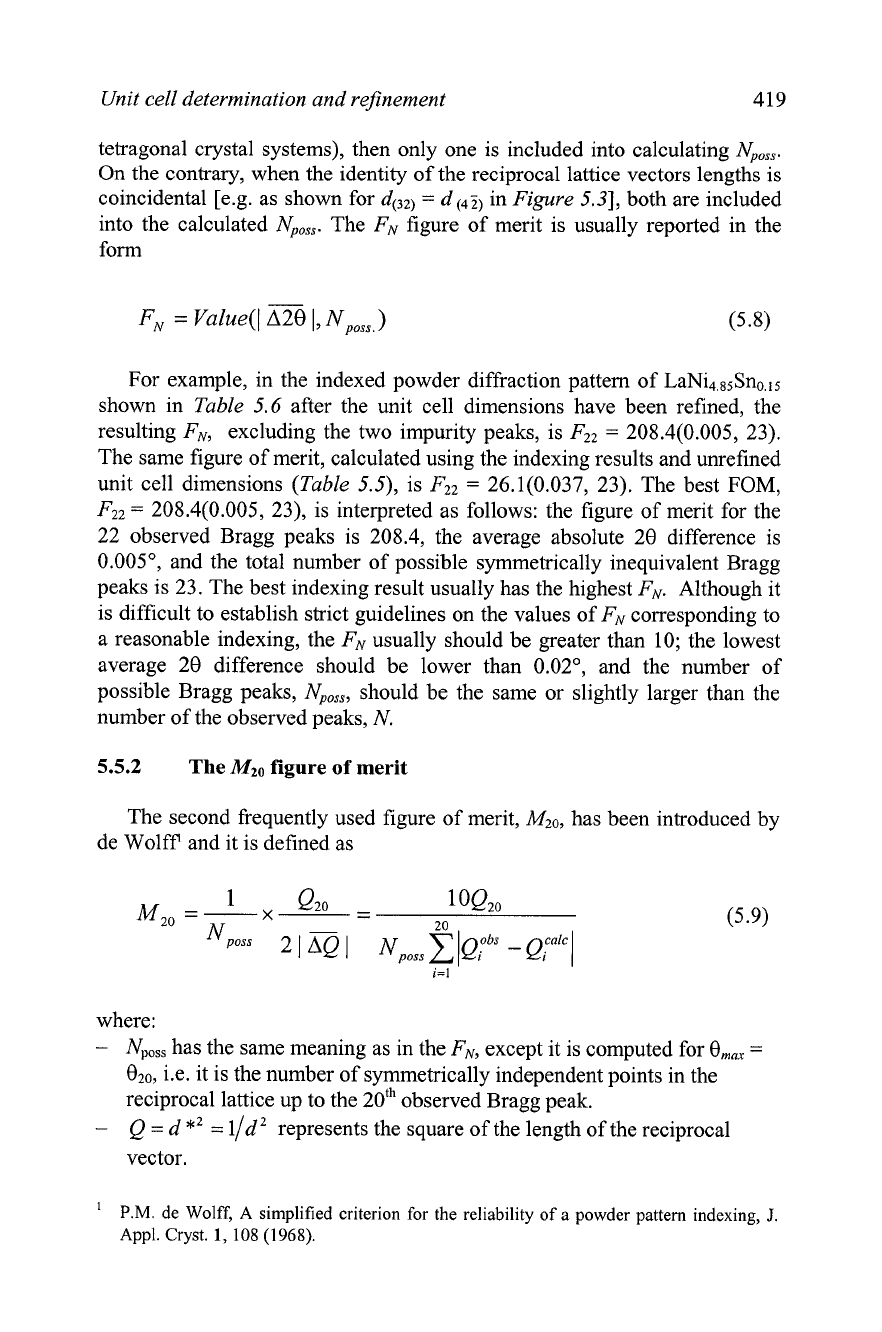
Unit cell determination and refinement
419
tetragonal crystal systems), then only one is included into calculating
N,,,.
On the contrary, when the identity of the reciprocal lattice vectors lengths is
coincidental [eg as shown for d(32)
=
d
(42)
in Figure 5.31, both are included
into the calculated N,,,. The
FN
figure of merit is usually reported in the
form
For example, in the indexed powder diffraction pattern of LaNi4,85Sno,lS
shown in Table 5.6 after the unit cell dimensions have been refined, the
resulting FN, excluding the two impurity peaks, is
F22
=
208.4(0.005, 23).
The same figure of merit, calculated using the indexing results and unrefined
unit cell dimensions (Table 5.5), is
F22
=
26.1(0.037, 23). The best FOM,
F22
=
208.4(0.005, 23), is interpreted as follows: the figure of merit for the
22 observed Bragg peaks is 208.4, the average absolute 20 difference is
0.005", and the total number of possible symmetrically inequivalent Bragg
peaks is 23. The best indexing result usually has the highest FN. Although it
is difficult to establish strict guidelines on the values of
FN
corresponding to
a reasonable indexing, the
FN
usually should be greater than 10; the lowest
average 29 difference should be lower than 0.02", and the number of
possible Bragg peaks, Nposs, should be the same or slightly larger than the
number of the observed peaks, N.
5.5.2
The
MzO
figure
of
merit
The second fi-equently used figure of merit, M20, has been introduced by
de WolfF and it is defined as
where:
-
N,,,, has the same meaning as in the FN, except it is computed for
Om,
=
020, i.e. it is the number of symmetrically independent points in the
reciprocal lattice up to the 2oth observed Bragg peak.
-
Q
=
d *2
=
l/d represents the square of the length of the reciprocal
vector.
P.M.
de
Wolff, A simplified criterion for
the
reliability of a powder pattern indexing,
J.
Appl. Cryst.
1,
108
(1968).
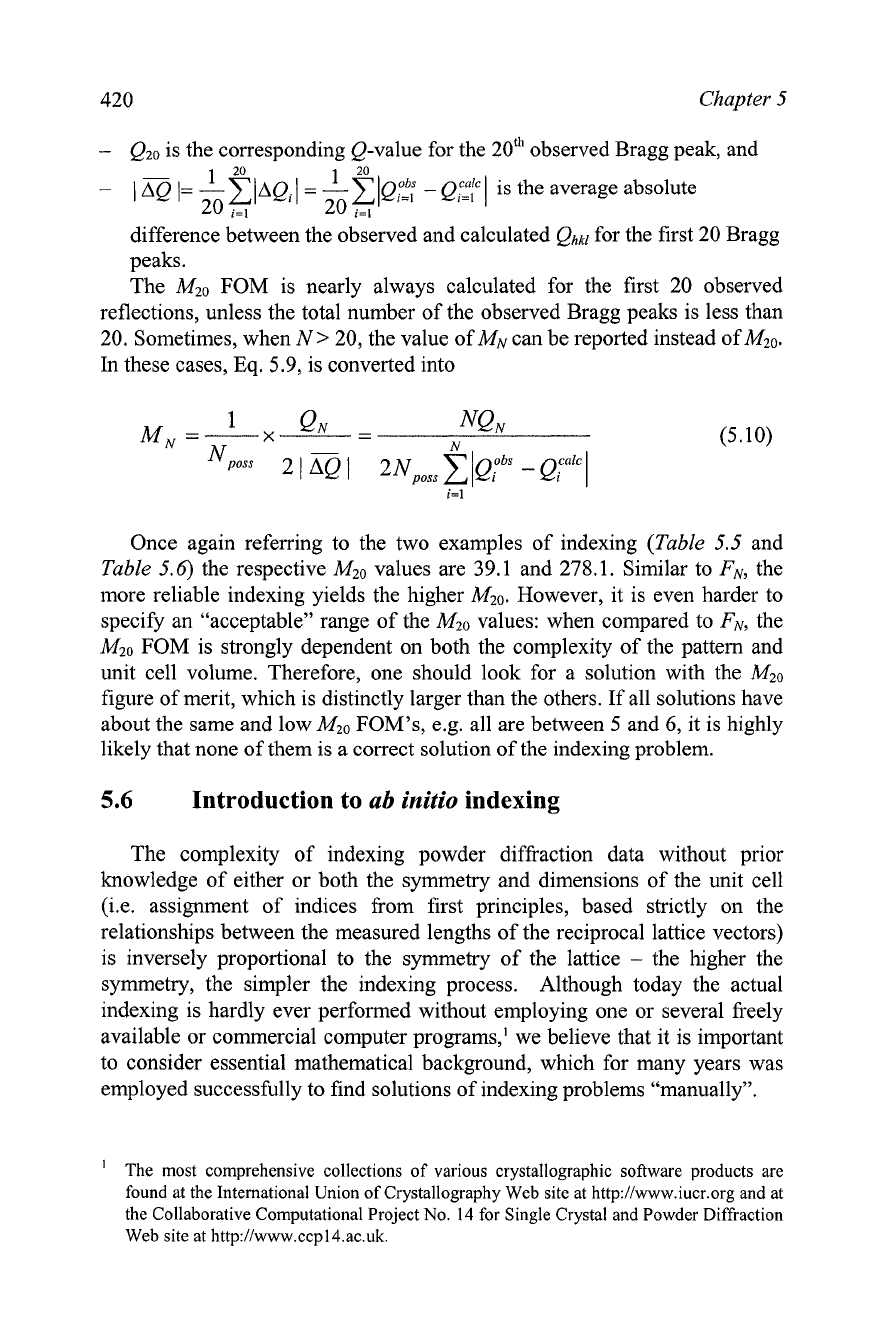
420 Chapter
5
-
Q20
is the corresponding Q-value for the 2oth observed Bragg peak, and
1
20
1
20
-
I
a
I=
-
C
~AQ~
1
=
-
C
-
Q;::
1
is the average absolute
20
i=,
20
i=,
difference between the observed and calculated
Qhkl
for the first 20 Bragg
peaks.
The
M20
FOM is nearly always calculated for the first 20 observed
reflections, unless the total number of the observed Bragg peaks is less than
20. Sometimes, when
N
>
20, the value of
MN
can be reported instead of
M20.
In
these cases,
Eq.
5.9, is converted into
Once again referring to the two examples of indexing (Table
5.5
and
Table
5.6)
the respective
Mzo
values are 39.1 and 278.1. Similar to FN, the
more reliable indexing yields the higher
Mzo.
However, it is even harder to
specify an "acceptable" range of the
Mzo
values: when compared to FN, the
M20
FOM is strongly dependent on both the complexity of the pattern and
unit cell volume. Therefore, one should look for a solution with the
M20
figure of merit, which is distinctly larger than the others. If all solutions have
about the same and low
M20
FOM's, e.g. all are between
5
and
6,
it is highly
likely that none of them is a correct solution of the indexing problem.
5.6
Introduction to
ab
initio
indexing
The complexity of indexing powder diffraction data without prior
knowledge of either or both the symmetry and dimensions of the unit cell
(i.e. assignment of indices from first principles, based strictly on the
relationships between the measured lengths of the reciprocal lattice vectors)
is inversely proportional to the symmetry of the lattice
-
the higher the
symmetry, the simpler the indexing process. Although today the actual
indexing is hardly ever performed without employing one or several freely
available or commercial computer programs,' we believe that it is important
to consider essential mathematical background, which for many years was
employed successfully to find solutions of indexing problems "manually".
'
The most comprehensive collections of various crystallographic software products are
found at the International Union of Crystallography Web site at http://www.iucr.org and at
the Collaborative Computational Project No.
14
for Single Crystal and Powder Diffraction
Web site at http://www.ccpl4.ac.uk.

Unit cell determination and refinement
42 1
We will begin with the cubic crystal system, where the assignment of
indices is nearly transparent and then consider the theory behind the
ab initio
indexing in crystal systems with tetragonal and hexagonal symmetry.'
Indeed, as with any kind of experimental work, experience is paramount, and
we hope that the contents of this section may help the reader to achieve
accurate solutions of real life indexing tasks successfully.
Accurate indexing from first principles rests on the four cornerstones:
1. The availability of Bragg peaks observed at the lowest possible Bragg
angles. These peaks are critically important because they have the
simplest indices (usually -2
I
h
I
2, -2
I
k
I
2 and -2
I
1
I
2), which
considerably limits the possibilities of locating the corresponding vectors
in the reciprocal lattice and therefore, simplifies the whole process of
restoring reciprocal lattice vector directions from their lengths.
2. The absence of a large number of extinct Bragg peaks, especially at low
Bragg angles. For example, if due to a variety of reasons all observed
Bragg peaks taken into account during the indexing have one of the
indices divisible by two, then the resulting unit cell dimension will be
112
of the true value.
3.
The high absolute accuracy including the absence of any kind of a
systematic error affecting the measured Bragg angles. This requirement is
obvious as only the lengths, but not the directions of the reciprocal
vectors are measurable in powder diffraction. The presence of even a
small systematic error
(e.g. sample displacement andor zero shift errors)
may considerably affect the outcome of the indexing because it usually
has the strongest influence on the lowest Bragg angle peaks, which are
critical for successful indexing (see item 1 in this list, and
Eq.
5.29 and
Figure
5.18,
below).
In
any case, systematic experimental errors should
be minimized by proper alignment of the instrument. If necessary, an
additional set of experimental data can be collected with a
well-
characterized internal standard added to the studied powder thus enabling
one to eliminate the present systematic errors from the data before
attempting
ab initio
assignment of indices.
4.
The absence of impurity Bragg peaks in the array of experimental data. If
this requirement is not met and one or more impurity peaks are included
in the indexing attempt, it is nearly always true that the reciprocal vectors
from the impurity phase do not fit within the correct reciprocal lattice of
the major crystalline phase. The resulting unit cell, if a solution is ever
found, more often than not will be incorrect as it describes both the
vectors from the major phase and the impurity
phase(s) in the same
'
An excellent description of the
ab
initio
indexing in all crystal systems can be found in
H.
Lipson and
H.
Steeple, Interpretation of x-ray powder diffraction patterns, Macmillan,
London; St. Martin's Press, New York
(1970).
